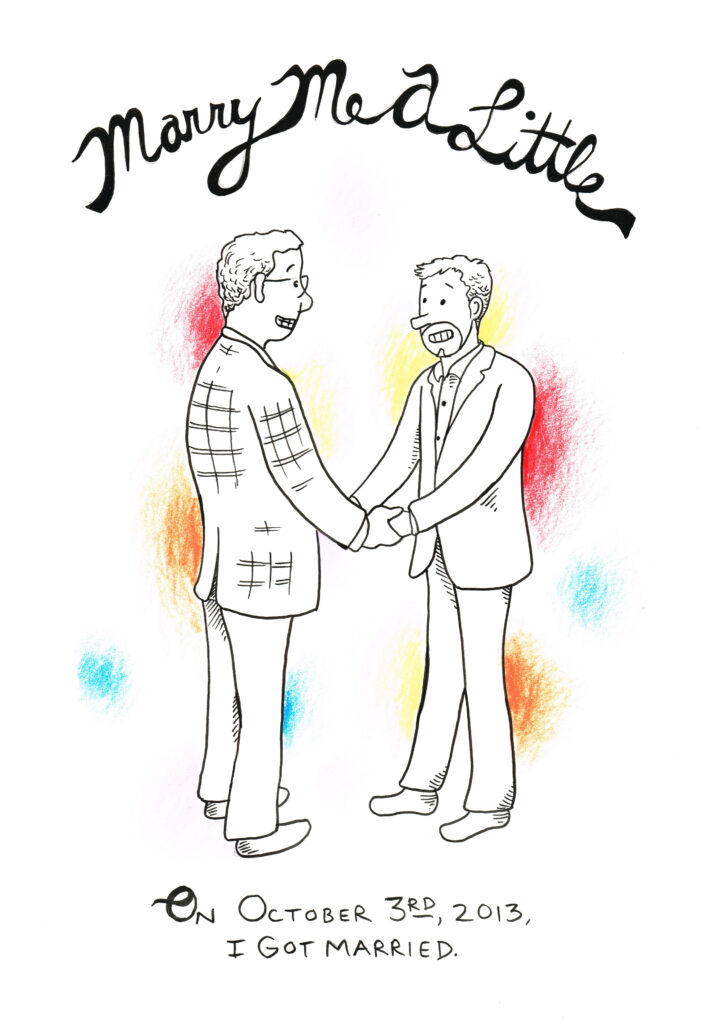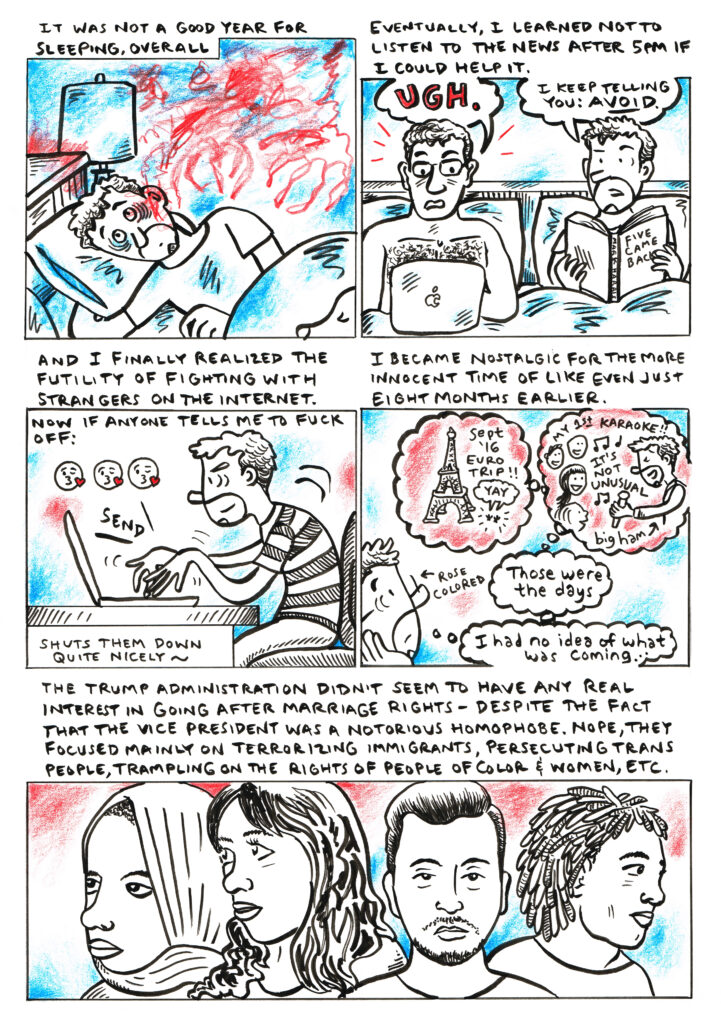Last updated on October 10, 2024
by Priya Saxena

In Marry Me a Little: A Graphic Memoir, Rob Kirby chronicles his experience marrying his partner John after marriage equality was made law in their home state of Minnesota. Using a simple cartooning style and a limited color palette, Kirby explores the contradictory politics of gay marriage and his personal feelings on the subject. He also shows how his relationship helped him cope with major political and life changes after Trump was sworn into office in 2016. BoC had the opportunity to interview Rob Kirby about Marry Me a Little, on sale now from Graphic Mundi.

First, I’d like to ask you about the title of your memoir: Marry Me a Little. It’s the title of a love song, which feels apt given that this book has a section dedicated to wedding songs, but it also fits this book very well. It’s sweet and irreverent but also suggests an impulse to downplay your marriage and keep it out of the spotlight. In the book, you describe how you and John were often reluctant to make a big deal of your wedding. Yet you ended up writing a whole book about it. Can you talk about how you chose the title for this book and what you hoped it would express to readers?
The title of Sondheim’s ambivalent song was so perfect there was no other option I’d even considered going with. John and I remained low-key about getting married all along, so much so that I think we may have done ourselves a disservice. A dear friend of mine was living in San Francisco at the time of our nuptials, and we had practically told out-of-town people not to come, just so not to make a fuss. We were so weirdly shy about it. At one of my recent readings here in the Twin Cities, my friend told me that he really regrets not having been at the ceremony. I apologized to him for discouraging him—I wish he had been there too!
I found my ambivalence towards the whole Getting Married thing to be the most interesting thing about the situation all along. For me, unresolved feelings in and of themselves often make the basis for a compelling story (if I had been gung-ho about it all I don’t think the book would have been terribly interesting to read). And the fact was that, however I might feel about the institution of marriage, that same-sex couples could now legally tie the knot was genuinely historic. It was exciting! I’d never before imagined such a thing coming to pass in this country.
Your coloring style for the comic feels to me very playful and unique. The little splotches of color subtly add an extra layer to the storytelling and keep the memoir from feeling too serious. I like the abstract and “coloring outside the lines” quality — it feels like you’re queering your art in the same way that you’re queering marriage. Why did you decide to employ color in this way for this book?
The coloring scheme came about by accident. I don’t really keep a sketchbook, but I doodle a lot, and that’s often where I get visual ideas. I was just goofing around with colored pencils, and I really liked how they looked against the deep black of india ink, so I ran with it. I hit on red and blue as my core colors for a few reasons. One is that we live in a country that is deeply polarized into red (i.e. conservative) and blue (progressive) states. So naturally those colors felt very apropos for this story. The other is that each represents varying heightened emotions: red can be passion, rage, lust. Blue is dreamy, melancholy, meditative. Other colors come into play here and there as well, but red and blue anchored everything.
Your dog Ginger has such a strong presence in the book, even though she’s mostly just in the background. I love how you depict her unique way of greeting you by putting her body in between your legs; it seems so specific and real. When you show how you had to make the hard decision to put her to sleep in her old age, the pain of that loss is felt. For gay couples who choose not to have children, pets can become especially significant parts of the family. What was it like incorporating Ginger into your memoir? Why was it important to you to include her?
Ginger was my best buddy. I loved her so much, I still miss her to this day. There was no way I could have left her out of the book because she was so important to us both, a daily presence in our lives. The only time I cried during the creation of the book was when I had to write and draw about her leaving this world. That was one of the hardest days of my life, truly. But it was important to honor her memory and I’m so glad I could do that for her, and me as well, along with anyone out there who knows that very particular sorrow.
You discuss wedding narratives in music and film in one section of the memoir. Most of the songs and films you highlight are about heterosexual weddings, but they hold a variety of views toward marriage, with some more traditional and others more radical. How do you think representations of weddings in media influenced your own views on the subject and your approach to your own wedding? What kinds of stories about queer weddings and marriage would you want to see (or have you already seen)?
I’m actually surprised to this day that my book is the first full-length comic about getting same sex married! I kept worrying about it: “Ugh, someone’s going to beat me to the punch.” But no one did. I think some of that may be the sheer awfulness of the political landscape of the past 7-8 years, and how fraught things have been. Marriage rights seemed pretty secure much of that time, so I think a lot of people just worried about a lot of other, more pressing issues, such as the vicious scapegoating of trans folks. But yes: the messages we’ve received all our lives from mass media and culture about marriage and weddings were just begging to be discussed, even a little, so I felt the need to unpack them for myself. I’m still surprised at how quietly subversive Four Weddings and a Funeral is (especially that its hero never does get traditionally married), and realizing that Bridesmaids is not actually about marriage & weddings but rather about female friendships and rituals.
I didn’t even discuss everything I would have liked to. I wish I had been able to include The Wedding Banquet (1993) and Muriel’s Wedding (1994), both of which are fueled by other issues more so than their titles would imply (Banquet is heavily concerned with immigration, gay relationships, and intercultural mores and conflicts, while Muriel concentrates on issues of familial neglect and abuse and the nature of female friendships). Actually, I plan to draw a comic examining Muriel’s Wedding once all the book hubbub dies down a bit. In the meantime, I highly recommend both it and The Wedding Banquet! They’re wonderful films.

Right now the United States is in an odd time culturally with regards to LGBTQ+ rights; the legalization of gay marriage 8 years ago certainly encouraged mainstream acceptance of gay people in many places, yet several states are proposing and passing bills attacking the LGBTQ+ community, with trans people being the most targeted. How does it feel to be sharing your story now, in a time when queer existence and joy are being targeted by regressive legal policies and extremist hate groups? What do you hope the young queer people of today take away from your story?
If there’s one message in my little book that I wanted to impart it is: “Do it your way.” This extends to just about everything in life, but particularly with your wedding day. We are all besieged by so many cultural pressures in a million different areas of life, and wedding pressures serve as a microcosm for a lot of macro and micro aggressions, queer or otherwise. And those pressures can be highly volatile when wedding bells are set to ring. I know a woman who, when she was planning her wedding to her now-husband, told her father, “Dad, you aren’t giving me away, because I am not yours to give.” As far as I know her dad was fine with this, but she’d made it a point to own her event at the outset and not to let others do it for her (I believe she also had to really put her foot down about it being non-religious). That’s all John and I wanted with our event: the time and space to figure it out ourselves, for better and for worse. The pressure was real, even if we had a generally very easy time of it, overall. And despite our fretting, we ended up having a lovely evening. Never give up your joy! There are individuals and larger forces out there dedicated to sucking your rights and your happiness away. Own and protect your life.
And if you’re getting married, plan ahead – much easier that way!

Twin Cities cartoonist Rob Kirby has been making and publishing comics since the early ’90s, emerging from that era’s queer zine explosion before moving into the LGBTQ+ press and beyond. He is the author of Curbside Boys: the New York Years (2002) and the creator and editor of several anthologies, including two volumes of The Book of Boy Trouble (2006 & 2008), the Ignatz-nominated series THREE, for which he also received the 2011 Prism Queer Press Grant; the Ignatz Award–winning QU33R (2014), and The Shirley Jackson Project: Comics Inspired by her Life and Work (2016). His newest book is the graphic memoir Marry Me a Little, published by Graphic Mundi, which the New York Times called “Powerful and honest.”
Priya Saxena (she/her or they/them) is a writer and critic based in New York City who enjoys reading queer comics and watching campy television. You can follow them on Twitter at @lettersofpriya.
